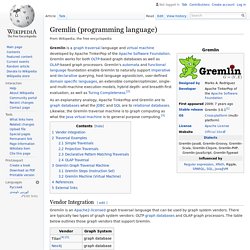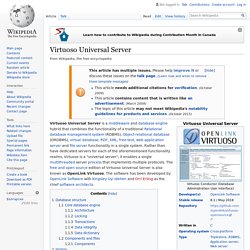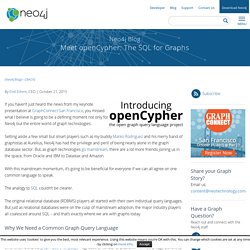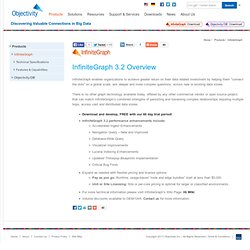

Fast, Scalable Graph Database & Graph Analytics Platform. JanusGraph: Distributed graph database. Graphistry. Graph rewriting. Graph Database. Enterprise Graph. Built for Cloud Applications Graph databases can help make sense of highly connected data, but a graph database by itself isn’t enough to satisfy the needs of modern cloud applications.

The power of a graph database can only be fully realized when paired with the functionality of advanced analytics, real-time indexing and search. With competitive offerings, each of these requirements would need to be satisfied by an individual point solution. Because each set of requirements is solved by a separate solution, it’s up to the user to manage and keep all of these separate solutions in sync.
This complexity greatly increases the total cost of ownership, and time to market. Multi-Model Capabilities DataStax Enterprise Graph is part of the DataStax Enterprise multi-model platform, which provides support for key-value, tabular, JSON/Document, and graph data models. Enterprise Ready. Gremlin (programming language) Gremlin is an Apache2-licensed graph traversal language that can be used by graph system vendors.

There are typically two types of graph system vendors: OLTP graph databases and OLAP graph processors. The table below outlines those graph vendors that support Gremlin. user--rated[stars:0-5]-->movieuser--occupation-->occupationmovie--category-->category gremlin> g.V().label().groupCount()==>[occupation:21, movie:3883, category:18, user:6040] gremlin> g.V().hasLabel('movie').values('year').min()==>1919 gremlin> g.V().has('movie','name','Die Hard').inE('rated').values('stars').mean()==>4.121848739495798 Gremlin supports declarative graph pattern matching similar to SPARQL. The following traversal is a Gremlin traversal in the Gremlin-Java8 dialect. g.V().as("a").out("knows").as("b"). select("a","b"). by("name"). by("age") The Gremlin language (i.e. the fluent-style of expressing a graph traversal) can be represented in any host language that supports function composition and function nesting.
Ranking - popularity ranking of graph DBMS.
Virtuoso Universal Server. Database structure[edit] Core database engine[edit] Virtuoso provides an extended object-relational model, which combines the flexibility of relational access with inheritance, run time data typing, late binding, and identity-based access.

Virtuoso Universal Server database includes physical file and in memory storage and operating system processes that interact with the storage. There is one main process, which has listeners on a specified port for HTTP, SOAP, and other protocols. Architecture[edit] Virtuoso is designed to take advantage of operating system threading support and multiple CPUs.
The database has at all times a clean checkpoint state and a delta of committed or uncommitted changes to this checkpointed state. A transaction log file records all transactions since the last checkpoint. A single set of files is used for storing all tables. Locking[edit] Transactions[edit] All four levels of isolation are supported: Dirty read, read committed, repeatable read and serializable. Top 25 Graph Databases. Meet openCypher: The SQL for Graphs. By Emil Eifrem, CEO | October 21, 2015 If you haven’t just heard the news from my keynote presentation at GraphConnect San Francisco, you missed what I believe is going to be a defining moment not only for Neo4j but the entire world of graph technologies.

Setting aside a few small but smart players such as my buddy Marko Rodriguez and his merry band of graphistas at Aurelius, Neo4j has had the privilege and peril of being nearly alone in the graph database sector. But, as graph technologies go mainstream, there are a lot more friends joining us in the space, from Oracle and IBM to Datastax and Amazon. With this mainstream momentum, it’s going to be beneficial for everyone if we can all agree on one common language to speak. The analogy to SQL couldn’t be clearer. The original relational database (RDBMS) players all started with their own individual query languages.
Objectivity – InfiniteGraph. InfiniteGraph enables organizations to achieve greater return on their data related investment by helping them “connect the dots” on a global scale, ask deeper and more complex questions, across new or existing data stores.

There is no other graph technology available today, offered by any other commercial vendor or open source project, that can match InfiniteGraph’s combined strengths of persisting and traversing complex relationships requiring multiple hops, across vast and distributed data stores. Download and develop, FREE with our 60 day trial period! AllegroGraph RDFStore Web 3.0's Database. Geospatial and Temporal Reasoning AllegroGraph stores geospatial and temporal data types as native data structures.

Combined with its indexing and range query mechanisms, AllegroGraph lets you perform geospatial and temporal reasoning efficiently. Social Networking Analysis AllegroGraph includes an SNA library that treats a triple-store as a graph of relations, with functions for measuring importance and centrality as well as several families of search functions. Neo4j, the World's Leading Graph Database.